#horseradish root
Text
Walking into Whole foods to get some fresh horseradish root to make homemade horseradish sauce.
January 2023
#short clip#whole foods#horseradish root#horseradish#horseradish sauce#homemade#raw vegan#vegan#raw Vegan recipe#vegan recipe#raw vegan horseradish sauce#january 2023
0 notes
Text
CarolCooks2…Friday Food Reviews…Edible Roots...Part 1...
CarolCooks2…Friday Food Reviews…Edible Roots…Part 1…
Welcome to Friday Food Reviews, where I will cover a different food or product each week and look at… what they are. where do they grow, what can we substitute them for in a recipe, and are they safe to eat, store, use, cook, or anything connected to that food? or product..all the why’s and the wherefores…it will, of course, be mainly my own opinion or a known fact…good or bad…there may even…

View On WordPress
0 notes
Text
I'm currently re-reading the Witcher Saga and I am at the point when Regis invites Geralt and company to his little hut and they eat horsemeat, horseradish and drink mandrake moonshine and the whole time I am like GIRLLLL DINNNEREER
#I also love how they just casually eat horseradish#i was grating horseradish roots when I was a kid for Easter and I remember crying beacause of how the fumes of it were getting into my eyes#what a kathargic experience it was#emiel regis#witcher#witcher books#witcher saga#wiedzmin#wiedźmin#baptism of fire#emiel regis rohellec terzieff de godefroy#geralt z rivii#geralt of rivia#zoltan chivay#milva#milva witcher#jaskier#dandelion
44 notes
·
View notes
Text
does anyone know what to do with horseradish…….
7 notes
·
View notes
Text
I know everyone followed this blog to hear my condiment opinions and obsessions. Well the condiment of the day is peri-peri sauce (hot of course!) with its sour tang and tangy sourness. Lemony. Hot. Delicious. Will take the nation by storm when Nando’s finally expands out of the DC metro god only knows why it’s exclusively there. Hungoverly piling lentil based protein slop on a piece of toast but I topped it with some sauce and now I’m having a cheeky Nando’s. Brilliant on my part I must say. Mouth has come alive. Just perfect. If you’ve never tasted it you’re gonna wanna! And now back to our regularly scheduled programming (disappears for five hours)
#I’m going to be processing horseradish root today wish me luck do#*xo#and hopefully making carrot kraut but see aforementioned hangover
13 notes
·
View notes
Text

HORSERADISH
It has a kick!
#digital art#animal#procreate#illustration#art#digital illustration#comedy#silly#pun#pun intended#horse#radish#horseradish#root#vegetable#food#food animal#foodimal
3 notes
·
View notes
Text
making the mashed potatoes for my roast dinner with american potatoes from safeway bc I didn’t go to work on thursday so I couldn’t get locally-grown yellow potatoes that were dug less than 24 hours ago like I planned

2 notes
·
View notes
Text
Planting Horseradish from Roots
Tender Horseradish Roots
Horseradish roots are used as a spice in meat, sandwiches, salads, and drinks. When mixed with vinegar or mayonnaise, it makes a paste that has a taste like mustard and wasabi. The peppery effects on the nasal and eye mucous membranes more than the taste buds.
Dividing Horseradish Roots
Older horseradish roots can be fibrous, but these roots are the most resilient for…
0 notes
Text
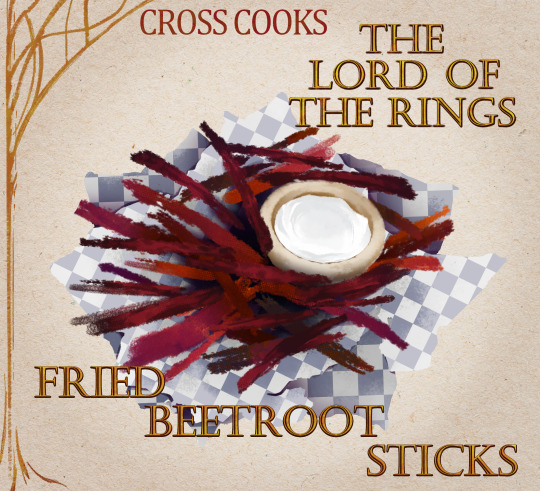
Hiiii friendssss! What the FUCK is up. What the fuck is up. What the Fuck is up. On todays cute little cookin excursion we are going to be deep frying things and using a wok. If you dont feel comfortable deep frying, and dont have a wok, im sure theres other ways to do it silly :DDD
I believe in you.
From LotR online we're gonna be making Fried Beetroot Sticks!!
(As always you can find the cooking instructions and full ingredient list under the break-)
MY NAMES CROSS NOW LETS COOK LIKE ANIMALS
SO, “what goes into Fried Beetroot Sticks?” YOU MIGHT ASKSlices of sweet little beated root dipped into a batter with, watch out, special flavors too.
2 Beetroots
Corn flour
Salt
Red Chilli Powder
Garlic Paste
Baking Soda
Water
Peanut oil
And we'll also be making some horseradish sour cream dip to go along with it;
Sour cream
Prepared horseradish
1 Green onion
Few splashes of lemon juice
Salt to taste
Ground pepper to taste
"Cooked, tender beetroot sticks are dredged in a light batter and fried to give a crispy exterior and a soft, sweet interior. Served with a bracing horseradish sour cream, this snack is both filling and delicious."- LotRO Tooltip
AND, “what does Fried Beetroot Sticks taste like?” YOU MIGHT ASKThis is like homemade fair-food and it sounds like a contradiction but its not
But maybe its just because its fried food? American brained, sorry.
Retains the inherit sweetness to beetroot
And similar to pickled beetroot the sweetness contrasts the spicey of the batter
(which i encourage you to amp up if youd like more spice)
The horseradish sourcream dip is to die for
Measure with your heart for that one, and save some green onion to top it with when you serve
This would pair very well with a lime italian soda or with shaved ice cones
Im always very anxious about deep-frying things, or working with oils at high temperatures, but i didnt run into any complications with this dish. Just make sure to keep best practices and safety precaution in mind, especially with a wok as it can tilt!
. If you dont have corn flour, you can substitute all-purpose flour
. If you dont have peanut oil, look up oils with the same smokepoint to decide what else to use
-----------------------------------------------------------------------------------------------------------
The recipe stuck out to me, as i was assembling a list of foodstuffs from tolkiens work, for being such a "regular" named food. Also its worth 19 silver 69 copper in the LotR MMO and im immature.
I think the dip has the most room for improvement and tinkering. I've never made horseradish sourcream before, so more practiced tastebuds could perfect a simple thing like this. In the future id also like to try adding red pepper flakes along with the the powder and garlic paste, to give more visual variety and spice. I think cumin in the batter would be a nice midtone flavor too.
I give this recipe a solid 8/10 (with 1 being food that makes one physically sick and 10 being food that gives one a lust for life again.) for its relative simplicity and modularity with things you could add.
🐁 ORIGINAL RESIPPY TEXT BELOW 🐁
Beetroot Sticks Ingredients:
2 Beetroots
130 grams corn flour
1 tbsp salt
1 tsp Red Chilli Powder
1 tsp Garlic Paste
1/4 tsp Baking Soda
178 grams Water
432 grams peanut oil
Horseradish Sour Cream Ingredients:
225 grams Sour cream
200 grams Prepared horseradish
1 whole green onion (green and white parts VERY finely chopped)
1 tspn lemon juice
Salt to taste
ground pepper to taste
Beetroot Method:
Peel all beetroots and cut them length-wise into rectangles.
Combine flour, salt, chilli powder, garlic paste, baking soda, and water in a bowl.
Mix well into a smooth batter.
Heat peanut oil to medium in a wok and dip beet roots into batter. Deep fry until golden brown in color.
Stack beetroots on paper-towel lined plates to cool and dry as you go.
Serve with horseradish sour cream!
Dip Method:
Mix all ingredients
Cover and let stand at room temperature for 1 hour for the flavors to blend.
594 notes
·
View notes
Text
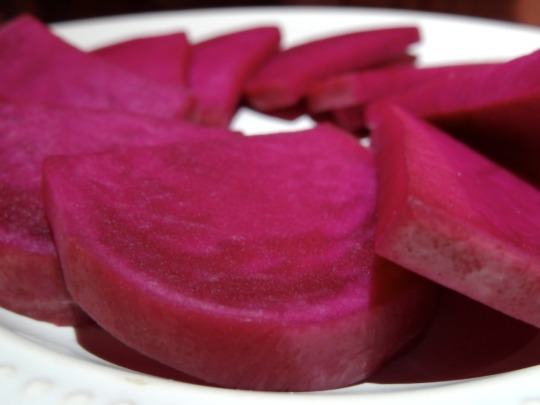
[ID: A circle of overlapping semi-circular bright pink pickles arranged on a plate, viewed from a low angle. End ID]
مخلل اللفت / Mukhallal al-lifit (Pickled turnips)
The word "مُخَلَّل" ("mukhallal") is derived from the verb "خَلَّلَ" ("khallala"), meaning "to preserve in vinegar." "Lifit" (with diacritics, Levantine pronunciation: "لِفِتْ"), "turnip," comes from the root "ل ف ت", which produces words relating to being crooked, turning aside, and twisting (such as "لَفَتَ" "lafata," "to twist, to wring"). This root was being used to produce a word meaning "turnip" ("لِفْتْ" "lift") by the 1000s AD, perhaps because turnips must be twisted or wrung out of the ground.
Pickling as a method of preserving produce so that it can be eaten out of season is of ancient origin. In the modern-day Levant, pickles (called "طَرَاشِيّ" "ṭarāshiyy"; singular "طُرْشِيّ" "ṭurshiyy") make up an important culinary category: peppers, carrot, olives, eggplant, cucumber, cabbage, cauliflower, and lemons are preserved with vinegar or brine for later consumption.
Pickled turnips are perhaps the most commonly consumed pickles in the Levant. They are traditionally prepared during the turnip harvest in the winter; in the early spring, once they have finished their slow fermentation, they may be added to appetizer spreads, served as a side with breakfast, lunch, or dinner, eaten on their own as a snack, or used to add pungency to salads, sandwiches, and wraps (such as shawarma or falafel). Tarashiyy are especially popular among Muslim Palestinians during the holy month of رَمَضَان (Ramaḍān), when they are considered a must-have on the إِفْطَار ("ʔifṭār"; fast-breaking meal) table. Pickle vendors and factories will often hire additional workers in the time leading up to Ramadan in order to keep up with increased demand.
In its simplest instantiation, mukhallal al-lifit combines turnips, beetroot (for color), water, salt, and time: a process of anaerobic lacto-fermentation produces a deep transformation in flavor and a sour, earthy, tender-crisp pickle. Some recipes instead pickle the turnips in vinegar, which produces a sharp, acidic taste. A pink dye (صِبْغَة مُخَلَّل زَهْرِي; "ṣibgha mukhallal zahri") may be added to improve the color. Palestinian recipes in particular sometimes call for garlic and green chili peppers. This recipe is for a "slow pickle" made with brine: thick slices of turnip are fermented at room temperature for about three weeks to produce a tangy, slightly bitter pickle with astringency and zest reminiscent of horseradish.
Turnips are a widely cultivated crop in Palestine, but, though they make a very popular pickle, they are seldom consumed fresh. One Palestinian dish, mostly prepared in Hebron, that does not call for their fermentation is مُحَشّي لِفِتْ ("muḥashshi lifit")—turnips that are cored, fried, and stuffed with a filling made from ground meat, rice, tomato, and sumac or tamarind. In Nablus, tahina and lemon juice may be added to the meat and rice. A similar dish exists in Jordan.
Turnips produced in the West Bank are typically planted in open fields (as opposed to in or under structures such as plastic tunnels) in November and harvested in February, making them a fall/winter crop. Because most of them are irrigated (rather than rain-fed), their yield is severely limited by the Israeli military's siphoning off of water from Palestine's natural aquifers to settlers and their farms.
Israeli military order 92, issued on August 15th, 1967 (just two months after the order by which Israel had claimed full military, legislative, executive, and judicial control of the West Bank on June 7th), placed all authority over water resources in the hands of an Israeli official. Military order 158, issued on November 19th of the same year, declared that no one could establish, own, or administer any water extraction or processing construction (such as wells, water purification plants, or rainwater collecting cisterns) without a new permit. Water infrastructure could be searched for, confiscated, or destroyed at will of the Israeli military. This order de facto forbid Palestinians from owning or constructing any new water infrastructure, since anyone could be denied a permit without reason; to date, no West Bank Palestinian has ever been granted a permit to construct a well to collect water from an aquifer.
Nearly 30 years later, the Interim Agreement on the West Bank and the Gaza Strip (also called the Oslo II Accord or the Taba Agreement), signed by Israel and the Palestine Liberation Organization (PLO) in 1995, officially granted Israel the full control over water resources in occupied Palestine that it had earlier claimed. The Argreement divided the West Bank into regions of three types—A, B, and C—with Israel given control of Area C, and the Palestinian Authority (PA) supposedly having full administrative power over Area A (about 3% of the West Bank at the time).
In fact, per article 40 of Annex 3, the PA was only allowed to administer water distribution in Area A, so long as their water usage did not exceed what had been allocated to them in the 1993 Oslo Accord, a mere 15% of the total water supply: they had no administrative control over water resources, all of which were owned and administered by Israel. This interim agreement was to be returned to in permanent status negotiations which never occurred.
The cumulative effect of these resolutions is that Palestinians have no independent access to water: they are forbidden to collect water from underground aquifers, the Jordan River, freshwater springs, or rainfall. They are, by law and by design, fully reliant on Israel's grid, which distributes water very unevenly; a 2023 report estimated that Israeli settlers (in "Israel" and in the occupied West Bank) used 3 times as much water as Palestinians. Oslo II estimations of Palestinians' water needs were set at a static number of million cubic meters (mcm), rather than an amount of water per person, and this number has been adhered to despite subsequent growth in the Palestinian population.
Palestinians who are connected to the Israeli grid may open their taps only to find them dry (for as long as a month at a time, in بَيْت لَحْم "bayt laḥm"; Bethlehem, and الخَلِيل "al-khalīl"; Hebron). Families rush to complete chores that require water the moment they discover the taps are running. Those in rural areas rely on cisterns and wells that they are forbidden to deepen; new wells and reservoirs that they build are demolished in the hundreds by the Israeli military. Water deficits must be made up by paying steep prices for additional tankards of water, both through clandestine networks and from Israel itself. As climate change makes summers hotter and longer, the crisis worsens.
By contrast, Israeli settlers use water at will. Israel, as the sole authority over water resources, has the power to transfer water between aquifers; in practice, it uses this authority to divert water from the Jordan River basin, subterranean aquifers, and بُحَيْرَة طَبَرِيَّا ("buḥayrat ṭabariyyā"; Lake Tiberias) into its national water carrier (built in 1964), and from there to other regions, including the Negev Desert (south of the West Bank) and settlements within the West Bank.
Whenever Israel annexes new land, settlers there are rapidly given access to water; the PA, however, is forbidden to transport water from one area of the West Bank to another. Israel's control over water resources is an important part of the settler colonial project, as access to water greatly influences the desirability of land and the expected profit to be gained through its agricultural exports.
The result of the diversion of water is to increase the salinity of the Eastern Aquifer (in the West Bank, on the east bank of the Jordan River) and the remainder of the Jordan that flows into the West Bank, reducing the water's suitability for drinking and irrigation; in addition, natural springs and wells in Palestine have run dry. In this environment, water for drinking and watering crops and livestock is given priority, and many Palestinians struggle to access enough water to shower or wash clothing regularly. In extreme circumstances, crops may be left for dead, as Palestinian farmers instead seek out jobs tending Israeli fields.
Some areas in Palestine are worse off in this regard than others. Though water can be produced more easily in the قَلْقِيلية (Qalqilya), طُولْكَرْم (Tulkarm) and أَرِيحَا ("ʔarīḥā"; Jericho) Districts than in others, the PA is not permitted to transfer water from these areas to areas where water is scarcer, such as the Bethlehem and Al-Khalil Districts. In Al-Khalil, where almost a third of Palestinian acreage devoted to turnips is located [1], and where farming families such as the Jabars cultivate them for market, water usage averaged just 51 liters per person per day in 2020—compare this to the West Bank Palestinian average of 82.4 liters, the WHO recommended daily minimum of 100 liters, and the Israeli average of 247 liters per person per day.
As Israeli settlement גִּבְעַת חַרְסִינָה (Givat Harsina) encroached on Al-Khalil in 2001, with a subdivision being built over the bulldozed Jabar orchard, the Jabars reported settlers breaking their windows, destroying their garden, throwing rocks, and holding rallies on the road leading to their house. In 2010, with the growth of the קִרְיַת־אַרְבַּע (Kiryat Arba) settlement (officially the parent settlement of Givat Harsina), the Jabars' entire irrigation system was repeatedly torn out, with the justification that they were stealing water from the Israeli water authority; the destruction continued into 2014. Efforts at connecting and expanding Israeli settlements in the Bethlehem area continue to this day.
Thus we can see that water deprivation is one tool among many used to drive Palestinians from their land; and that it is connected to a strategy of rendering agriculture impossible or unprofitable for them, forcing them into a state of dependence on the Israeli economy.
Turnips, as well as cabbage and chili peppers, are also grown in the village of وَادِي فُوقِين (Wadi Fuqin), west of Bethlehem. In 2014, Israel annexed about 1,250 acres of land in Wadi Fuqin, or a third of the village's land, "effectively [ruling] out development of the village and its use of this land for agriculture." Most of this land lies immediately to the west of a group of settlements Israel calls גּוּשׁ עֶצְיוֹן ("Gush Etzion"; Etzion Bloc). Building here would link several non-contiguous Israeli settlements with each other and with القدس (Al-Quds; "Jerusalem"), hemming Palestinians of the region in on all sides (many main roads through Israeli settlements cannot be used by anyone with a Palestinian ID). [2] PLO executive committee member Hanan Ashrawi said that the annexation, which was carried out "[u]nder the cover of [Israel's] latest campaign of aggression in Gaza," "represent[ed] Israel’s deliberate intent to wipe out any Palestinian presence on the land".
This, of course, was not the beginning of this strategy: untreated sewage from Gush Etzion settlements had been contaminating crops, springs, and groundwater in Wadi Fuqin since 2006, which also saw nearly 100 acres of Palestinian land annexed to allow for expansion of the Etzion Bloc.
All of this has obviously had an effect on Palestinian agriculture. A 1945–6 British survey of vegetable production in Palestine found that 992 dunums were devoted to Arab turnip production (954 irrigated and 38 rain-fed; no turnip production was attributed to Jewish settlers). A March 1948 UN report claimed that "[i]n most districts the markets are well-supplied with all the common winter vegetables—cabbages, cauliflowers, lettuce and spinach; carrots, turnips and and beets; beans and peas; green onions, eggplants, marrows and tomatoes." By 2009, however, the area given to turnips in Palestine had fallen to 918 dunums. Of these, 864 dunums were irrigated and 54 rain-fed. This represents an increase in unirrigated turnips (5.8%, up from 3.9%) that is perhaps related to difficulty in obtaining sufficient water.
Meanwhile, Israel profits from its restriction of Palestinian agriculture; it is the largest exporter of turnips in West Asia (I found no data for turnip exports from Palestine after 1922, suggesting that the produce is all for local consumption).
The pattern that Ashrawi called out in 2014 continued in 2023, as Israel's genocide in Gaza occurs alongside the continued and escalating killing and expulsion of West Bank Palestinians. The 2014 annexations, which represented the largest land grab for over 30 years and which appeared to institute a new era of state policy, have been followed up in subsequent years with more land claims and settlement-building.
Israeli military and settler raids and massacres in the West Bank, which had already killed 248 in 2023 before the حَمَاس (Hamas) October 7 offensive had taken place, accelerated after the attack, with forced expulsions of Palestinians (including Bedouin Arabs), and harassment, raids, kidnappings, and torture of Palestinians by a military armed with rifles, tanks, and drones. This violence has been opposed by armed resistance groups, who defend refugee camps from military raids with strategies including the use of improvised explosives.
Support Palestinian resistance by buying an e-sim for distribution in Gaza; donating to help two Gazans receive medical care; or donating to help a family leave Gaza.
[1] 918 dunums were devoted to turnips according to the Palestinian Central Bureau of Statistics (PCBS) report for 2009; the 2008 PCBS report attributes 253 dunums of turnip cultivation to Al-Khalil ("Hebron") for 2006–7.
[2] Today, Gush Etzion is connected to Al-Quds by an underground road that runs beneath the Palestinian Christian town of بَيتْ جَالَا (Bayt Jala).
Ingredients:
Makes 2 1-liter mason jars.
500g (4 medium) turnips
1 beetroot
1 medium green chili pepper (فلفل حار خضرة), halved
2 small cloves garlic, peeled
1 liter (4 cups) distilled or filtered water
25g coarse sea salt (or substitute an equivalent weight of any salt without iodine)
Some brining recipes for lifit call for the addition of a spoonful of sugar. This will increase the activity of lactic-acid-producing bacteria at the beginning of the fermentation, producing a quicker fermentation and a different, sourer flavor profile.
Instructions:
1. Clean two large mason jars thoroughly in hot water (there is no need to sterilize them).
2. Scrub vegetables thoroughly. Cut the top (root) and bottom off of each turnip. Cut each turnip in half (from root end to bottom), and then in 1 cm (1/2") slices (perpendicular to the last cut). Prepare the beetroot the same way.
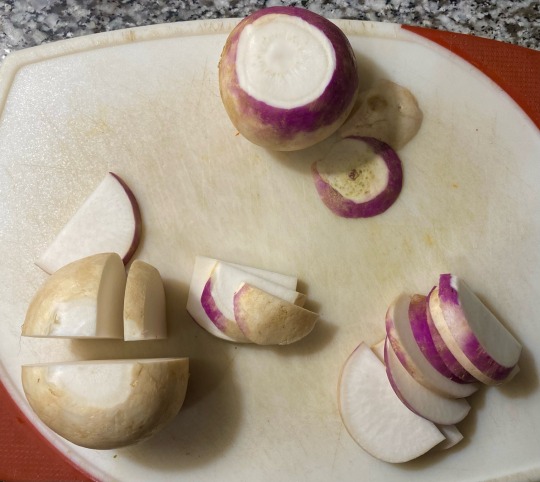
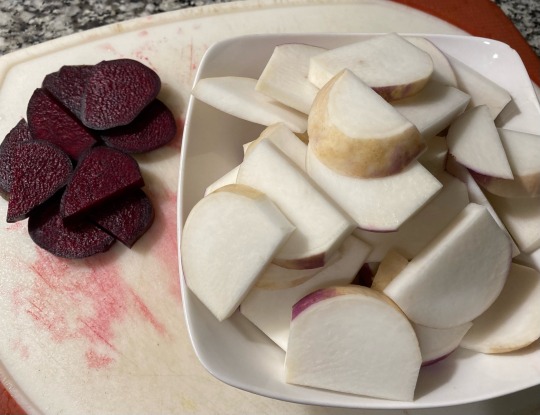
If you need your pickles to be finished sooner, cut the turnips into thinner slices, or into thick (1/2") baton shapes; these will need to be fermented for about a week.
3. Arrange turnip and beet slices so that they lie flat in your jars. Add garlic and peppers.
4. Whisk salt into water until dissolved and pour over the turnips until they are fully submerged. Seal with the jar's lid and leave in a cool place, or the refrigerator, for 20–24 days.

The amount of brine that you will need to cover the top of the vegetables will depend on the shape of your jar. If you add more water, make sure that you add more salt in the same ratio.

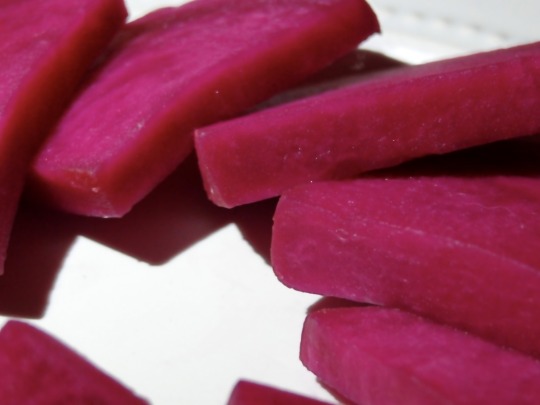
292 notes
·
View notes
Text
Botanicals by purpose [long post]
Attraction: adam & eve root, agar, allspice, almond, aloe, althea root, ambergris, angelica, apple, apricot, balm of gilead tears, basil, bay laurel, bee pollen, benzoin, bergamot, bistort, blackberry, bladderwrack, blue violet, buckeye, catnip, cedar, chamomile, chickweed, clover, cloves, columbine, cotton, cowslip, damiana, deer's tongue, dill, elecampane, eucalyptus, evening primrose, frangipani, gardenia, henna, hibiscus, honey, honeysuckle, hyacinth, iris, jasmine, job's tears, juniper, lavender, lemon balm, lemon verbena [vervain], licorice, lobelia, lovage, mandrake, marigold, marjoram, may flowers, morning glory, mullein, myrtle, nutmeg, oak, olive, orange, orange blossom (neroli), orris root, parsley, passion flower, peony, periwinkle, pineapple, plumeria, safflower, sassafras, strawberry, sweet bugle, sweet pea, thyme, tonka bean, tuberose, vetiver, wheat, yellow dock, yerba mate, ylang ylang
Banishing: basil, betel nut, black pepper, black salt, cayenne pepper, chamomile, cactus, cloves, dragon's blood, elder, garlic, heliotrope, horehound, juniper, morning glory, mullein, mugwort, oleander, onion, rosemary, rue, sage, sea salt, st. john's wort, thyme, tobacco, vinegar, wood betony, yarrow flower
Beauty: avocado, beet, catnip, chamomile, evening primrose, flax, ginkgo biloba, ginseng, henna, lady's mantle, lemon, lilac, lucky hand (orchid root), magnolia, maidenhair, myrtle, orange, orange blossom (neroli), orchid, pea, prune, rose, sunflower, violet, yerba santa
Binding: agrimony, buttercup [crowfoot], calamus, hydrangea, ivy, knotweed, morning glory, skullcap, snapdragon, solomon's seal, spanish moss, spiderwort, vinegar, witch hazel
Cleansing/purification: angelica, anise seeds, black pepper, cayenne, cedar, citronella, cloves, coconut, dragon's blood, fennel, fern, frankincense, garlic, ginger, grapefruit, guava, honey, horehound, horseradish, hyssop, lavender, lemon, lemongrass, lemon verbena [vervain], lime, marjoram, melon, mesquite, parsley, peppermint, pine, rosemary, sage, sandalwood, sea salt, solomon's seal root, tangerine, thyme, turmeric, vinegar, yucca
Confidence: basil, bergamot, bindweed, cardamom, cedar, celandine, cinquefoil, coconut, cypress, dogwood, ginger, grapefruit, honeysuckle, motherwort, nutmeg, orange, orange blossom (neroli), sunflower, tobacco, yarrow flower
Courage: acorn, allspice, basil, bergamot, blue violet, borage (starflower), cardamom, cinnamon, citronella, cloves, clover, columbine, dragon's blood, eyebright, fennel, frankincense, garlic, geranium, iris, ivy, mullein, musk, mustard seed, oak, pokeweed, ragweed, raspberry, rose, rosemary, st. john's wort, sweet pea, tarragon, thyme, turmeric, yarrow flower
Creativity: citronella, dragon's blood, fig, lavender, lemon verbena [vervain], orange, pomegranate, rosemary, tangerine, valerian, wild cherry bark, willow, yellow pepper
Cursing: angelica, asafoetida, bayberry, bindweed, blackberry root, black salt, bladderwrack, bloodroot, blueberry, boneset, chicory, chili powder, cinquefoil, cloves, cramp bark, dragon's blood, hemlock, henbane, jezebel root, knot weed, lemon, lemon verbena [vervain], lime, mace, mandrake, mullein, mustard seed, myrrh, belladonna (nightshade), onion, patchouli, poke root, poppy seed, rue, spanish moss, slippery elm, stinging nettle, sumac, tormentil, vetiver, wormwood (absinthe), yew, yohimbe bark
Divination: almond, angelica, anise seeds, arrow root, basil, bay leaf, catnip, cedar, cinnamon, cinquefoil, clary sage, cloves, copal, dandelion, elder, frankincense, garlic, hazel, holly, honeysuckle, iris root, lavender, lemongrass, lilac, maple, meadowsweet, mugwort, myrrh, nutmeg, onion, orange, parsley, peppermint, pine, pomegranate, poppy seeds, rose, rowan, safflower, sage, sandalwood, star anise, sunflower, thyme, uva ursi, willow, wormwood (absinthe), yarrow flower
Dreams: anise seeds, bay leaf, buchu, catnip, chamomile, cinquefoil, damiana, dandelion root, elder, goosegrass, grapes, heliotrope, hibiscus, holly, hops, hyacinth, jasmine, lavender, lemon verbena [vervain], lovage, mandrake, marigold, marjoram, mimosa, mugwort, mullein, onion, peppermint, rose, rosemary, sage, st. john's wort, star anise, thyme, valerian, violet, wood betony, yarrow flower
Energy: allspice, aloe, amber, angelica, belladonna (nightshade), black walnut, carrot, centaury, cherry bark, coffee, cowslip, cramp bark, daffodil, damiana, dragon's blood, fig, frankincense, ham, hawthorn, lovage, mint, oregano, paprika, parsley, peppermint, red pepper, sage, sandalwood, spinach, sunflower, tangerine, vanilla, walnut
Fidelity: cardamom, chili pepper, clover, cumin, hydrangea, licorice root, magnolia bark, olive, rhubarb, rye, vetch, yerba mate
Fertility: acorn, apple, banana, barley, birch, bistort, cabbage, carrot, celery, chickweed, cucumber, cyclamen, daffodil, egg, fenugreek, fig, ginkgo biloba, grapes, hawthorn, hay, hazelnut, ivy, lily, mandrake, mistletoe, mugwort, mulberry, mustard seed, myrtle, oak, olive leaf, palm, parsley, patchouli, peach, pomegranate, poppy seeds, pork, prickly ash bark, rhubarb, rice, rye, sesame seed, shave grass, squaw vine, walnut, watercress, wheat, yellow dock, yohimbe bark
Happiness: anise, apple, azalea, banyan, bee pollen, beech, catnip, cherry, cumin, cyclamen, fern, geranium, hawthorn, honey, honeysuckle, hyacinth, jasmine, lavender, lemon, lily, lily of the valley, marjoram, meadowsweet, orange, orange blossom (neroli), palm, peach, persimmon, quince, rose, saffron, st. john's wort, witches grass (dog grass)
Healing: adder's tongue, african violet, agrimony, allspice, almond, angelica, apple, arrow root, aspen, balm of gilead tears, barley, bay leaf, bayberry, belladonna, blackberry, calamus, carnation, cedar, chamomile, chia, chickweed, cinnamon, cotton, cucumber, cypress, dandelion leaf, eucalyptus, fennel, feverfew, flax seed, gardenia, garlic, ginkgo biloba, ginseng, goldenseal, hops, horse chestnut [buckeye], ivy, lavender, lemon balm, lemon verbena [vervain], melon, mesquite, mint, mistletoe, myrrh, olive leaf, peppermint, persimmon, pineapple, plantain, plum, potato, raspberry leaf, rose hips, rosemary, rowan, rue, saffron, sage, sandalwood, sassafras, saw palmetto, spearmint, thistle, white willow bark, willow, wood betony, yarrow flower, yerba santa
Hex-breaking: asafoetida, bamboo, chili pepper, datura, galangal, holy thistle, huckleberry, hydrangea, mimosa, nutmeg, papaya, peony, pokeroot, prickly ash bark, rue, squill, thistle, toadflax, true unicorn root, vetiver, wintergreen, witches grass (dog grass), yew, yucca
Invisibility: aconite (wolfsbane, monkshood), amaranth, black haw, cherry bark, chicory, fig, heliotrope, poppy seeds, sow thistle, tansy
Legal matters: buckthorn, calendula flower, cascara, celandine, galangal, hickory, lovage, marigold, skunk cabbage, tobacco
Love: acacia, allspice (pimento), apple, apricot, avocado, balm of gilead, barley, basil, beans, beetroot, bloodroot, buttercup [crowfoot], cabbage, cardamom, celery, cherry, chestnut, chickweed, chili peppers, cilantro [coriander], coltsfoot, copal, corn, cornflower, daffodil, dates, dogbane, dragon's blood, elm, fig, gardenia, geranium, ginseng, grapes, henbane, hibiscus, high john, honeydew, hyacinth, indian paintbrush, job's tears, juniper, kiwi, lady's mantle, lavender, leek, lemon, lemon balm, lemon verbena [vervain], lettuce, lime, liverwort, lobelia, lovage, maidenhair, mandrake, mango, maple, marjoram, marshmallow, meadowsweet, mint, mistletoe, moonwort, mullein, mushrooms, myrrh, myrtle, nectarine, nuts, orange, orchid, orris root, pansy, papaya, parsley, pea, peach, pear, peppermint, periwinkle, plum, quassia, quince, radish, raspberry, rose, rosemary, rue, rye, saffron, southern wood, spearmint, spiderwort, st. john's wort, strawberry, sugarcane, tangerine, thyme, tomato, turnip, vanilla, vetiver, willow, witches grass (dog grass), wood betony, wormwood (absinthe), yams, yarrow, yerba mate
Luck: acorn, agrimony, allspice (pimento), anise seeds, arrow root, bamboo, banana, bay leaf, cabbage, calamus, caraway, carrot, cassia, chamomile, cinnamon, corn, cotton, daffodil, dill, dragon's blood, fern, frankincense, galangal, hazelnut, kumquat, lucky hand (orchid root), nutmeg, orange, parsley, pear, peppermint, persimmon, pineapple, pomegranate, poppy seeds, red clover, rose, rue, star anise, strawberry, sunflower, vanilla, vetiver, violet, yarrow flower
Manifestation/power: acorn, bamboo, balm of gilead, bergamot, black haw, carnation, cayenne, cedar, cinnamon, cinquefoil, club moss, dittany, ebony, echinacea, frankincense, gentian, ginger, goldenseal, lady's mantle, mastic, mugwort, myrrh, rowan, sandalwood, st. john's wort, star anise, sunflower, witches burr, wormwood (absinthe)
Meditation: acacia, anise seeds, angelica, chamomile, copal, cypress, dittany, eucalyptus, frankincense, jasmine, lemon verbena, lotus, mugwort, myrrh, nutmeg, parsley, patchouli, red willow bark, rosemary, sage, sandalwood, thyme
Mental clarity: amber, basil, cardamom, cloves, fern, eyebright, ginkgo biloba, lavender, lemongrass, mulberry, rosemary, sage, sandalwood, spearmint, willow
Mental power: caraway, celery, coffee, eyebright, fenugreek, grapes, hazelnut, horehound, lily of the valley, mace, mustard, periwinkle, raisins, rosemary, rue, sage, summer savory, spearmint, vanilla, walnut, watercress, yellow pepper
Peace: aloe, apple, apricot, basil, blueberry, brussel sprouts, celery, chamomile, cilantro [coriander], coffee, coltsfoot, cornflower, cucumber, cumin, fig, gardenia, heather, hyacinth, jasmine, kola nut, lavender, lemon verbena [vervain], lettuce, lily of the valley, lime, magnolia flowers, maidenhair, marigold, meadowsweet, myrrh, myrtle, narcissus, olive leaf, orange, orange blossom (neroli), oregano, passion flower, passion fruit, pea, pennyroyal, peppermint, plum, rhubarb, rose, sage, skullcap, sweetgrass, tobacco, tuberose, valerian, violet, willow, ylang ylang
Prosperity/wealth: alfalfa, allspice, almond, banana, barley, basil, bay leaf, beef, bergamot, blackberry, bladderwrack, cashew, chamomile, cinnamon, cinquefoil, citronella, coltsfoot, comfrey, dill, eggplant, fenugreek, flax, fumitory, galangal, ginger, goldenrod, goldenseal, grains, grapes, green pepper, high john, honeysuckle, horse chestnut [buckeye], hyssop, irish moss, jasmine, kumquat, lavender, lemon verbena, lucky hand, mandrake, maple, marigold, mint, moss, myrtle, oak, oats, onion, orange, patchouli, pea, peanut, pear, pecan, pine, pineapple, pine nut, pineapple, pomegranate, poppy seeds, red clover, rice, sesame, snakeroot, spinach, tangerine, tomato, wheat, woodruff
Protection: acacia (gum arabic), aconite (wolfsbane, monkshood), acorn, african violet, aloe, amber, angelica, anise seeds, ash, bamboo, barley, basil, bay leaf, belladonna, bergamot, black haw (devil's shoestring), black pepper, blackberry, blessed thistle, bloodroot, blue violet, blueberry, boneset, brimstone (sulfur powder), buckwheat, cactus, calamus, calendula, carnation, caraway, catnip, cedar, chia, chives, chrysanthemum, cilantro [coriander], cinnamon, cloves, clover, coconut, comfrey, corn, cotton, cramp bark, cranberry, cumin, curry, cypress, dandelion root, datura, devil's bit, devil's claw, dill, dogwood, dragon's blood, ebony, elder, eucalyptus, fennel, fern, feverfew, fleabane, foxglove, frankincense, gardenia, garlic, geranium, ginger, ginseng, heather, heliotrope, henna, hickory, high john the conqueror, holly, horseradish, irish moss, ivy, juniper, kava kava, kelp, lady slipper, larch, larkspur, laurel, lavender, leek, lemon verbena [vervain], lettuce, lime, lotus, mandrake, marigold, marjoram, marshmallow root, mimosa, mint, mistletoe, mullein, nutmeg, oak moss, olive leaf, onion, papyrus, peat moss, peony, pimpernel, pineapple, plantain, quince, radish, raspberry leaf, rhubarb, rice, rowan, rue, sandalwood, saw palmetto, sea salt, slippery elm, snapdragon, solomon's seal, spanish moss, spearmint, st. john's wort, straw flower, sunflower, tangerine, thistle, valerian, venus fly trap, violet, witch hazel, wood aloe, woodruff, wormwood (absinthe), yerba santa, yew, yucca
Psychic abilities: acacia (gum arabic), ambergris, anise seeds, arnica flowers, bay leaf, bistort, bladderwrack, borage (starflower), buchu, butcher's broom, calendula, camphor, celery/celery seed, cinnamon, coconut, damiana, deer's tongue, eyebright, fish, galangal, honeysuckle, kava kava, kelp, lemon balm, lemongrass, lotus, lovage, marshmallow root, mulberry, mugwort, mushrooms, myrrh, rowan, saffron, sage, star anise, tuberose, uva ursi, wisteria, yarrow flower, yerba santa
Relaxation/calming: basil, blue violet, cauliflower, cedar, chamomile, cucumber, cypress, hops, hyssop, juniper, kava kava, kola nut, lavender, lemon balm, lily of the valley, lime, mandarin, mugwort, narcissus, orange blossom (neroli), parsley, passion flower, rose, tuberose, skullcap, st. john's wort, valerian, vanilla, ylang ylang
Spell-breaking: ague, angelica, asafoetida, bamboo, basil, bay leaf, benzoin, boneset, brimstone (sulfur powder), burdock, chili pepper, cinquefoil, comfrey, datura, frankincense, galangal, garlic, geranium, holy thistle, huckleberry, hydrangea, iris root (orris root), lemon verbena [vervain], lilac, lily, lucky hand (orchid root), myrrh, oak moss, onion, oregano, patchouli, rue, safflower, solomon's seal, st. john's wort, stinging nettle, squill, thistle, toadflax, turmeric, vetiver, willow, wormwood (absinthe), yarrow flower
Strength: balsam, bay leaf, beef, bee pollen, blessed thistle, borage (starflower), broccoli, calamus, calendula flower, camphor, carnation, cedar, cinnamon, dates, echinacea, endives, fennel, fig, gentian, ginger, heliotrope, high john, irish moss, leek, lime, marjoram, milk thistle, mulberry, oak, oak moss, orchid, oregano, parsley, pennyroyal, pine, pine nut, red peppers, saffron, sow thistle, spearmint, st. john's wort, stinging nettle, tangerine, tea leaves, thyme, tobacco, vanilla, willow, wood betony
Success: angelica, apple, basil, bay leaf, benzoin, cedar, cinnamon, frankincense, garlic, ginger, high john, lemon balm, lemon verbena [vervain], lucky hand (orchid root), marigold, mistletoe, mustard, myrrh, oak, onion, sandalwood, solomon's seal, st. john's wort, strawberry, sunflower, valerian, vetiver, wood aloe
Wisdom: acacia, acorn, almond, angelica, bay leaf, benzoin, cassia, cinnamon, cinquefoil, elder, frankincense, goosegrass, hazelnut, honey, iris, lilac, milk thistle, mulberry, peach, oak, sage, solomon's seal, sunflower
Wishes: bamboo, bat's head root, bay leaf, beech, black walnut, blowball, buckthorn, dandelion leaf/root, dogwood, ginseng, job's tears, lotus root, peppermint, pomegranate, sage, sandalwood, spearmint, star anise, sunflower, tonka bean, walnut, willow

© 𝟸𝟶𝟸𝟺 𝙰𝙳-𝙲𝙰𝙴𝙻𝙴𝚂𝚃𝙸𝙰
93 notes
·
View notes
Text
better than revenge | chapter five: smash!



Lorenzo Berkshire x Reader (ft. Ex!Mattheo Riddle)
Series trope: Fake dating
Chapter five summary: You and Enzo get to know each other and end up showing him how studying together can be fun. 1.8k words.
Warning: Cursing, angst, fluff, no use of y/n, slight suggestiveness.
♡ main masterlist
series masterlist | previous chapter | next chapter

“The best way to deal with your anger, aside from good ol’ revenge,” Enzo starts, “is to break shit.”
“When you said we were going to The Breaking Point, I didn’t think you meant it literally,” I say, looking at graffiti scrawled all over the building tucked neatly in an alley.
“Come on, it’s going to be fun,” he says holding my hand and leading me inside.
Once we’ve got our safety gear on, Enzo reaches for the dishes and consecutively throws three plates against the wall. The smashing of plates sounds almost melodic, like wind howling through chimes.
“Stressful week, huh?” I ask him.
“I’m getting my ass handed to me in Potions,” Enzo replies, throwing another plate for good measure.
He hands me a pile, “but never mind that. Your turn. Think of something that angers you, imagine they’re the plate and then throw it.”
I think of Mattheo’s annoying smile and take aim. Crash!
The sound of his laugh. Smash!
Seeing him kiss her. Crash!
I still love him. Smash!
I’m such an idiot. Crash!
I’m out of breath when the final pieces crash on the floor.
⭐︎⭐︎⭐︎
“I haven’t felt this good in weeks!” I exclaim, twirling on the sidewalk as we make our way to dinner. I ignore the curious glances I attract and walk ahead, beaming.
Enzo laughs, “told you, I’ve got ways to help you release stress—”
“Without being a perv,” I finish his sentence.
“Not what I was going to say, but okay,” he muses.
“You winked at me! It’s your fault I assumed, Lorenzo Berkshire” I glare at him.
He raises his hands to concede. “Fine fine, but never call my by my full name again. You’re scary,” he shudders.
“Tell me more about Potions,” I say, tamping down my smile.
“I’ve been having a hard time memorizing the right ingredients. I keep mixing up horse hair and horseradish, or moondew and moonseed. Why do they have to sound so similar?” he explains, running a hand through his hair in exasperation.
“That sucks, I can see why it can be confusing,” I say, fixing his hair absentmindedly.
“I can help you study!” I offer.
He smirks, “you know, Mattheo and I compete with grades. He may be naturally smarter and doesn’t have to apply himself as much, I’ll give him that. But I work hard and even skipped a grade because of it. It’s how we’re in the same grade even though I’m younger and I’ve been lording it over him ever since. But Potions…”
I see where he’s going. “Potions is a nightmare. So by studying together, you’ll get better grades and outrank Mattheo again. Even more incentive to help, fake boyfriend. Let’s make that phase two of The Book.”
I grab his arm and see him smiling down at me. “Let’s study at your dorm next week, it’s gonna be fun!”
“Why not at the library so people can see us?” He asks, quirking an eyebrow.
“Because my ways are not allowed at the library, it’s loud but fun,” I say.
“Oh?” He asks with a devilish smile.
“I did not wink at you, Berkshire! I didn’t mean it that way,” I smack his arm.
He laughs, “I’ve never heard the term ‘fun’ and ‘studying’ in the same sentence, but if anyone can do it, it’s probably you.”
⭐︎⭐︎⭐︎
“Have you ever heard of mnemonics?” I ask Enzo.
“Stop making up words.”
“I’m not! Mnemonics is a way we can memorize things through key phrases and words. Okay, so look at this,” I open a Potions textbook to one of the instructions.
“Felix felicis, liquid luck. To create this, you need ashwinder egg, horseradish and heat. No horse hair here. To make it easy to remember, use the phrase “ashes take root in the heat.”
“How does that make it easier?”
“The key word you need to remember is ashes. What do they do? They take root in the heat. Ash is short for ashwinder egg and next time you’re confused between horse hair or horseradish, remember which one is the root vegetable?”
“Horseradish!” He exclaims. “Ashes take root in the heat. You make this so much easier! Why can’t you be our Potions professor instead?”
“Snape would have your head if he hears you,” I say. “But wait, we haven’t got to the fun part yet. Once you have your phrase, you then have to turn it into a song.”
Enzo laughs indulgently, “like one of those children shows?”
“You laugh at my methods, Berkshire. But it won’t be so silly once you’re exceeding expectations in class. You gotta trust the process.”
“Does the process know we’re trusting it?” He quips.
“Isn’t it so much easier memorizing song lyrics than class notes?” I retort. He nods, considering me.
“Come on, Enzo. We can even sing it to the tune of your favorite song.” He gives me a pained look but gives in and hours go by, we have our key phrases and songs that go with potion ingredients and techniques.
Laughing, Enzo takes my hand and lifts me off the chair, spinning me around. “We’ve done the singing, now let’s dance.”
“But there’s no music,” I comment as my cheeks flush when I feel his hands on waist, inviting me to sway with him.
“Move with me,” he says, “we can use this as practice for when we attend a ball.”
I close my eyes and imagine music as I follow his steps, trying to avoid stepping on his foot. His hands feel strong and reassuring, guiding me as he hums a soft tune. We move in comfortable silence and I relax into the moment.
“You did well today,” I tell him as he spins me again and he bows, marking the end of the dance.
“Only because I had a fantastic teacher,” he remarks. “I’ll definitely outrank Mattheo with you by my side.”
“What’s the deal with you and Mattheo, anyway? Why are you rivals?” I ask.
“It’s therapy time, huh?” He says, settling in his bed and I sit beside him. He takes a moment, turning the question over in his mind. “It started when we were kids, our mother would have us play these games to see who bested each other. Did you know, we even competed to see who’d eat the most vegetables during dinner?”
“Well…” I say, bewildered. “That’s one way to get you to eat healthy, I guess?”
“We didn’t grow up in the same household, of course,” he continues. “So I only knew him through the occasional awkward family dinner. But our mother, if you scored better grades or won some contest, that’s when she would come visit and spend time with whoever won. We’ve been that way ever since,” he shrugs.
“You realize that’s not normal, right?” I ask.
“Is any family even normal?” He counters.
“No, family dynamics are weird. Mine isn’t any better,” I agree. “I just mean that you don’t have to compete for love. Someone can love you exactly as you are, you don’t have to earn it. That’s what my mother used to say” I explain.
He looks at my eyes, speechless and searching.
“You know that, right?” I try. Of course he doesn’t. “You don’t have to try hard to be loved.”
We sit in electric silence as he shifts his gaze down my mouth before meeting my eyes again. I want to hold this boy with sad eyes, so warm and full of life, but alone here in the privacy of his room it will be real.
“It’s getting late and Theo will be back soon from the party.” I clear my throat and brush off these feelings, whatever they are. I rise from his bed and take my things. “This was productive, let’s do it again tomorrow.”
He blinks, shaking off the moment. “Of course, yeah. Thank you.”
Enzo walks me to the door and bids me good night.
“Good night,” I reply, rising on my toes to kiss his cheek.
I walk back to my dorm and glance at my watch. It’s much later than I thought. I briefly pause when a voice interrupts my thoughts.
“If cuddling is the best part, he didn't do it right.” I look up and see Mattheo watching me come from the direction of Enzo’s dorm.
My annoyance flares, “Why hello to you too, Mattheo. Don’t you have some girl to disappoint?”
“Oh I never disappoint in bed,” he says with a smirk and I look at his dark eyes, remembering heated nights and all the ways I’ve come undone for him and with him. Memories of warm skin tangled in sheets, moaning messes, and the euphoric maze we lost and found ourselves in.
I shake my head and sigh, “do what you want, Riddle. It’s what you’re good at anyway.”
That shuts him up and I walk past him.
⭐︎⭐︎⭐︎
The next few weeks go by and Enzo and I get into a comfortable rhythm studying together. We spend meal times together at the Great Hall and visit Hogsmeade on weekends in the name of fake dating.
I approach Enzo as students file out the room from Potions class.
“Look here,” he beams, showing me his grade.
“Exceeds expectations! You did it, Enzo!” I engulf him in a hug and laugh in surprise as he twirls me around before setting me down.
He looks at Mattheo making his way to the exit and calls out, “not that I need a number to prove I’m better than you, brother, but it seems the numbers have spoken again.”
Mattheo pauses and looks back, “is it really a win, brother, if you needed someone’s help to get there?” He looks at me and raises an eyebrow.
Enzo puts his arm around me. “You mean, I get to outrank you, after skipping a grade by the way. And I have an incredible girlfriend by my side? I don’t see what the problem is.”
I step in, “Well Enzo, not everyone knows what they have when they have it.” I shift my gaze to Mattheo, “Matheo wouldn’t understand, now would you?” I shake my head condescendingly.
“Come on, we have to celebrate!” I wink at Enzo and he grins at our inside joke as we walk out.
When we reach the hallway, he leans in to whisper, “you winked! Are we really going to celebrate?”
I smack his arm and whisper back, “that was just for The Book. Behave.”
“Okay, just checking. Because you know I wouldn’t mind at all if—” I glare at him and he holds his hands up in retreat.
I soften, “You can, however, get a congratulatory kiss.” I pull my arms around his shoulders and kiss him. He smiles against my lips.

series masterlist | previous chapter | next chapter
♡ main masterlist
Author's note: I recently went to a similar place where I got to break stuff and I knew these characters had to do it too. I nearly named this chapter "break plates, not hearts" hahahaha.
Oh and Mattheo’s first line comes directly from an episode of Veronica Mars iykyk.
Taglist: @hoeforvinniehackerrr @i-think-you-are-gr8 @thecraziestcrayon @adreamingpendulum @themarauderswife7 @midsoulz @ultramarinetovelvet @val-writes @lafrone @daisiesformylove @mildly-delulu @allebasi05 @enha-stan @skb4000 @nat1221 @s0urw00lf
#lorenzo berkshire x reader#lorenzo berkshire x you#enzo berkshire x reader#enzo berkshire imagine#enzo x reader#mattheo riddle imagine#mattheoxreader#harry potter fanfiction#hp fanfic#mattheo riddle#lorenzo berkshire#mattheo riddle x you#mattheo x you#mattheo riddle x reader#slytherin boys#enzo berkshire#slytherin x reader#slytherin x slytherin#amongemeraldcloudswrites
194 notes
·
View notes
Text
Wow-Wow Sauce
For @redwineand12gaugeshells... :->
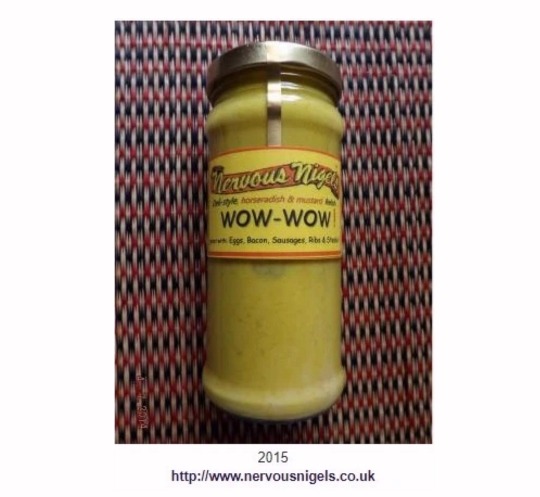
In fact that bottled sauce (and nervousnigels) no longer exists, and in any case its principal ingredients of (squints) horseradish and mustard are way off base.
Wow Wow sauce was meant to go with boiled beef, and since a major ingredient was the meat's broth *, it was more like a pan gravy made at the end of cooking, than something intended to go into / come out of a jar in the preserves cupboard.
* 1817 was well before stock / bouillon cubes, however "portable soup" was a Known Thing and could be a possible alternative. The recipe is specific about using fresh broth, but here's how to make portable soup, because You Never Know.
youtube
Real Wow Wow sauce had no hyphen, no sulphur, no saltpetre and definitely no grated wahoonie, though some "real" ingredients of the Discworld version - mangoes, figs, asafoetida, anchovy - suggest Terry was taking inspiration from labels in his own kitchen, such as those on HP Sauce, Worcestershire Sauce and Yorkshire Relish.
*****
Dr Kitchiner's "The Cook's Oracle" is available online from Gutenberg (the 1833 American adaptation) as well as a PDF of the 1822 UK Third edition from Internet Archive.
Here's his recipe - whose title, for extra interest, includes the original name for what became "Bully Beef":
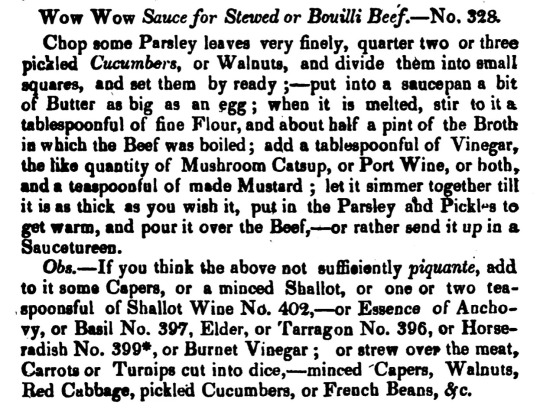
The good doctor's "pickled cucumbers" would have been vinegared like cornichons or gherkins, not brined like dill pickles. In addition, pickled walnuts are easier to find than they used to be; even the Tesco supermarket chain carries them...
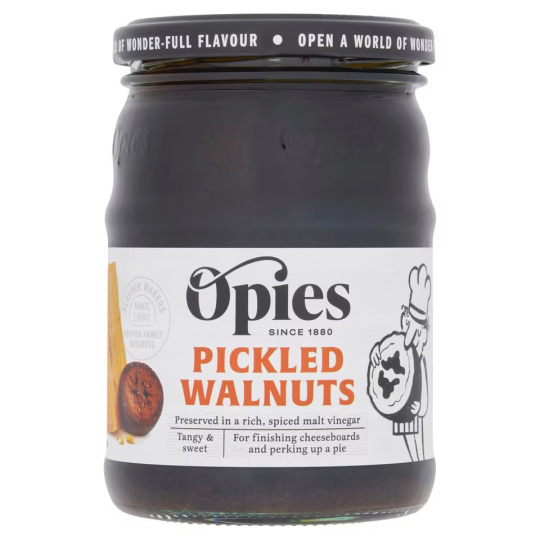
...as well as mushroom ketchup.
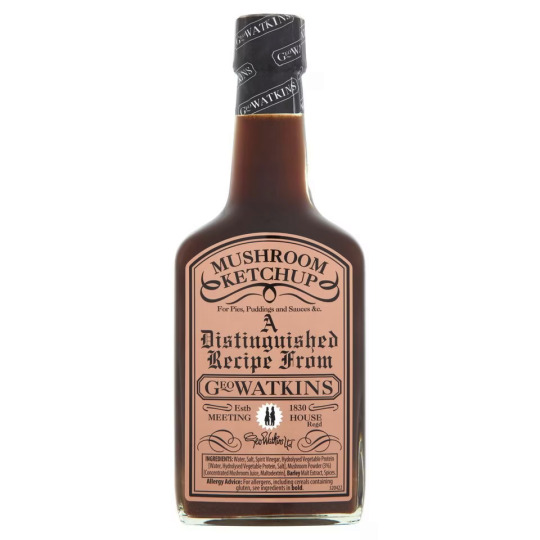
You'd probably still need to make the other herb vinegars and the shallot wine (based on dry sherry), but those are easy, just a matter of steeping the herbs in the liquid for a week or so then straining off and bottling the flavoured fluid.
Another useful ingredient for period cooking is anchovy sauce, which is less, er, emphatic than full-on anchovy essence. You could always scale up if you like the taste.
This also has the advantage of being a pleasant - if you like fishiness - sauce in its own right; try a teaspoonful in a tablespoonful of EV olive oil then tossed with hot pasta. Yum...!

This one's from the same company as the mushroom ketchup and the packing clearly emphasises their "period-ness" (is that a word?) The anchovy sauce is a bit harder to find, but well worth tracking down.
*****
Finally, here's a Youtube short of Wow Wow sauce being made and sampled. It looks entirely acceptable, like a cross between a thin chutney and a thick sauce, and would be, to use Dr Kitchiner's own word, "piquante".
youtube
As a side-note, that by-play with tinned corned beef was a bit pointless, since its texture and flavour are both utterly unlike beef that's been slowly, gently boiled (simmered, TBH) with halved onions, carrots, root veggies etc.
Use shin or silverside; the magic tenderiser for those cheap cuts is Time (or a pressure cooker) - though you can also add a sprig or two of Thyme if you want...
#food and drink#wow wow sauce#wow-wow sauce#Dr Kitchiner#The Cook's Oracle#historical food#GNU Terry Pratchett#Youtube
210 notes
·
View notes
Text



Plant of the Day
Thursday 18 July 2024
The hardy perennial Armoracia rusticana 'Variegata' (variegated horseradish) is a vigorous and potential invasive plant. Both the species and variegated cultivar will grow in most soils and locations, but thrives in rich moist soil and some sun. It is cultivated for its large white, tapered root.
Jill Raggett
#Armoracia#variegated horseradish#horseradish#edibles#herbaceousperennial#herbaceous#herb#plants#invasive species#horticulture#gardens#garden#orkney
88 notes
·
View notes
Text

Wild Horseradish. A spicy root found in the spring.
one more to go for spring forageables!
#sdv forageables#botanical#botanical illustration#wip#horseradish#flora#plants#stardew valley#my art
108 notes
·
View notes
Text



garlic mustard (alliaria petiolata) is the most invasive little bitch around. not only do the roots exude a chemical that inhibits the growth of other plants, it produces seeds like a MONSTER
i may not be able to win any real battle against this assclown, but i like to do my small part by eating a lot of it. in the spring the young greens are yummy, and the roots have a horseradish taste that’s pretty good. and speaking of seeds…
garlic mustard seeds are a more mild version of yellow or brown mustard seeds, and can be used as a substitute for both. i use it in my pickling spice mix and let me tell you, it is FIRE 🔥
50 notes
·
View notes